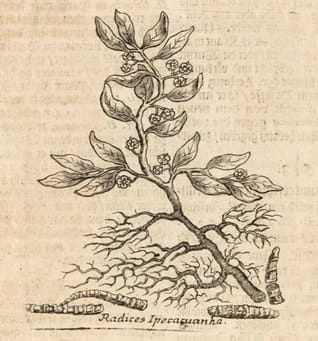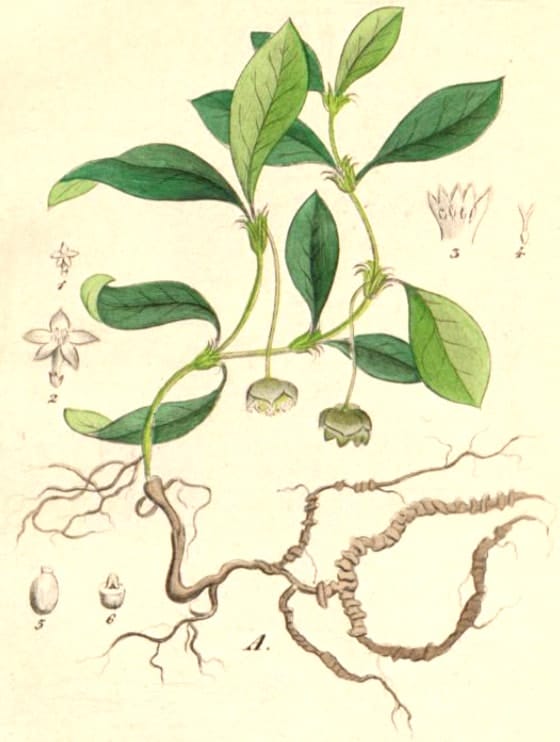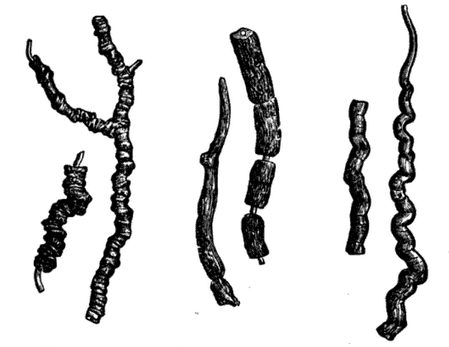IpecacuanhaIpecacTu Gen (TCM) |

|

|
 Ipecacuanha
IpecacuanhaMuseum Museorum, Valentini, 1704
 Ipecacuanha
IpecacuanhaHand-Atlas Medicinisch-Pharmaceutischer, 1884
 Left: Ipecacuanha; Center: Striated Ipecacuanha; Right: Undulated Ipecacuanha
Left: Ipecacuanha; Center: Striated Ipecacuanha; Right: Undulated IpecacuanhaBotanical name:
Carapichea ipecacuanha (syn. Cephaelis ipecacuanha, Psychotria ipecacuanha)
Grey (Peru), Brown (Brazil), White, Red and Black types were sold, all said to be derived from the same plant.
However, other sources of Ipecacuanha were available on the market:
- Striated Ipecacuanha: Psychotria emetica
- Undulated Ipecacuanha: Richardsonia scabra
- White Ipecacuanha: Ionidium Ipecacuanha
Parts used:
Root
Temperature & Taste:
Very Warm, Dry. Bitter, Pungent. Toxic
Classifications:
3O. EMETICS
TCM:
F. Emetics
Uses:
1. Clears Phlegm:
-expectorant for Cough, Bronchitis, Whooping Cough, Croup, Asthma with excess phlegm (small doses)
2. Promotes Vomit:
-used as an emetic; considered the surest and safest vegetable emetic
-other conditions with excess Phlegm including Epilepsy
-used for poisoning
3. Clears Damp, Resists Poison:
-Dysentery ‘they frequently conquer the disease in the space of one day’ (Treatise on Foreign Drugs, 1749) (West, TCM)
-proven amoebicide
-Antidote for Snake poisoning
Dose:
1. Most people will achieve emesis after one dose, approximately 10–15% require a second dose. Around 4–5% of people don’t vomit after administration of Ipecac.
2. ‘Where it fails of operating upwards [vomit], it commonly purges, and sometimes considerably’. (An Experimental History of the Materia Materia, Lewis, 1784)
Powdered Rhizome: As an expectorant: 60–300mg; As an emetic: 1–2 grams
Very small doses (20–30mg) have apparently been successful in severe Uterine hemorrhage, Pneumonia and Pleurisy.
Ipecac Syrup: 0.4–1.4 mls as an expectorant, 15 mls (1 tablespoonful) as an emetic.
Substitute:
As noted above, the following alternate species have been sold as types of Ipecacuanha:
1. Striated Ipecacuanha: Psychotria emetica
2. Undulated Ipecacuanha: Richardsonia scabra
Main Combinations:
1. Dysentery:
i. Ipecacuanha (1 scruple), Syrup of Quinces (qs) to form a Bolus. (Treatise on Foreign Drugs, 1749)
ii. Ipecacuanha (6 grains), Rhubarb (1 scruple), Syrup of Chicory and Rhubarb (qs), form a Bolus
iii. Ipecacuanha (18 grains), Conserve of Rose, Conserve of Rosehip (1 oz. each), Venice Treacle (2 drams), Syrup of Quince (qs to make an Electuary). Dose: 1 dram twice daily. (Treatise on Foreign Drugs, 1749)
iv. if there is great weakness, Confection of Hyacinth, Diascordium (1 dram each), Ipecacuanha powder (10 grains), Syrup of Quince (1 oz.), Cinnamon water (half oz.), Plantain water, Balm water (3 oz. each). Mix. Take a spoonful every hour. (Treatise on Foreign Drugs, 1749)
v. After initial symptoms reside, the following can be taken twice daily until fully recovered: Diascordium (1 dram), Ipecacuanha (1 grain). Mix and take as a dose. (Treatise on Foreign Drugs, 1749)
vi. Ipecacuanha, Opium (as in Dover’s Powder)
vii. Ipecacuanha (1 dram), Opium (half dram), Camphor (2 drams), Cream of Tartar (half oz.). Dose: 10 grains–1 teaspoonful. (Vitalogy, 1906)
2. Catarrh of the Stomach, minute doses of Ipecacuanha and Rhubarb
3. Expectorant:
i. Ipecacuanha (4 grains), Tincture of Lobelia (1 dram), Syrup of Squill (2 oz.)
4. Asthma:
i. ‘In violent paroxysms, a scruple procures great and immediate relief’. (An Experimental History of the Materia Materia, Lewis, 1784)
ii. ‘For habitual indisposition, from three to five grains every morning, or from five to ten every other morning, may be given for a month or six weeks’. (An Experimental History of the Materia Materia, Lewis, 1784)
iii. Ipecacuanha, Senega (equal parts of the fluid extract)
iv. Ipecacuanha, Lobelia, Horehound
5. Croup, Syrup of Ipecac, 5–10 drops every 5 minutes until vomiting occurs.
6. Uterine Hemorrhage:
i. ‘In the Stockholm acls 1770, are several cases of uterine hæmorrhagies cured by 1/3 or 1/2 grain [20–30mg], rubbed with sugar, given every four hours or oftener. In one case, the hæmorrhage returned on discontinuing the medicine, and ceased on repeating it’.
ii. Fluid Extract of Ipecacuanha, Fluid Extract of Digitalis (2 drams each), Fluid Extract of Ergot (4 drams). Mix. Dose: 30 drops–1 teaspoonful every 2–4 hours. (Vitalogy, 1906)
7. Gout, Ipecacuanha, Extract of Colchicum, Calomel, Extract of Aloes (1 grain each), Extract of Nux Vomica (quarter grain) (Vitalogy, 1906)
Major Formulas:
Cautions:
1. Usually causes nausea, even in lower doses.
2. Not used during Pregnancy or Breastfeeding (except under medical guidance); not used in infants under 6 months of age or elderly patients with Heart disease.
3. Not used after consumption of corrosive agents, or “strychnine, corrosives such as alkalies (lye) and strong acids, or petroleum distillates such as kerosene, gasoline, coal oil, fuel oil, paint thinner, or cleaning fluid.” (Code of Federal Regulations, 2011)
4. Not used in unconscious patients; during convulsions; severe hypertension or bradycardia.
5. Caution when powdering this medicine. Inhalation of the fine dust has reportedly caused difficult respiration, bleeding from the nose, hemoptysis, inflammation of the eyes, face, nose and throat.
Toxicity:
LD50 for emetine (intraperitoneally in rats) is 12.1 mg/kg
LD50 for cephaeline (intraperitoneally in rats) is 9.9 mg/kg
Main Preparations used:
Syrup, Wine
1. Wine of Ipecac
Ipecacuanha (1 oz.), Orange peel (quarter oz.) macerated in wine (1 pint),
Dose: half–1 oz. (An Experimental History of the Materia Materia, Lewis, 1784)
